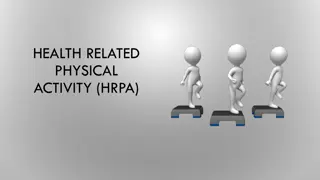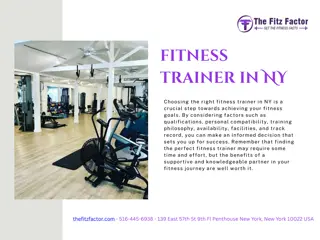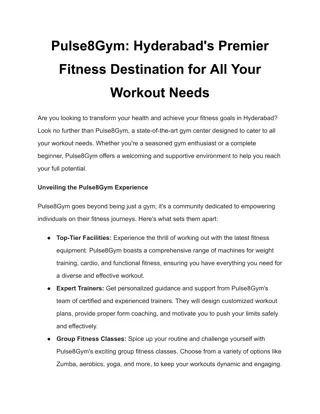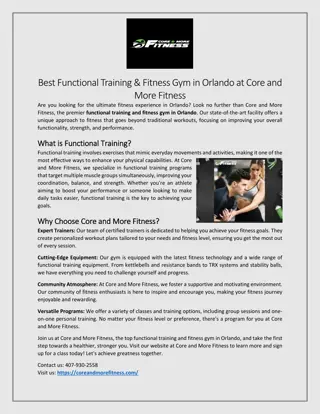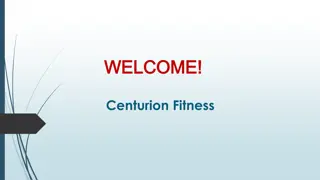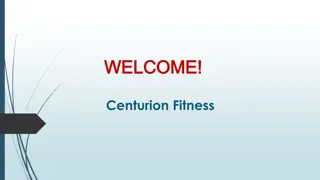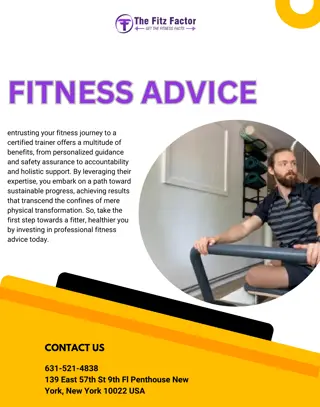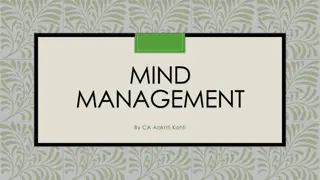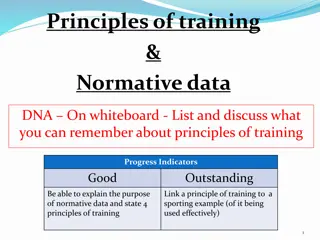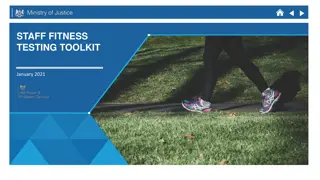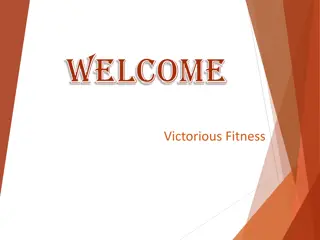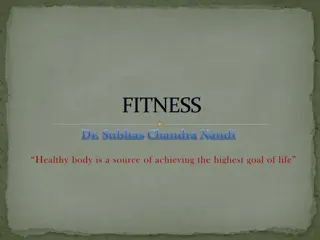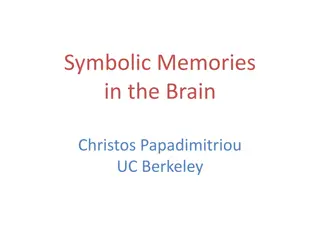Optimizing Brain Fitness for a Sharper Mind
In this informative content by Dr. Ann Polya and Dr. A. J. Polya, explore how to enhance brain fitness to improve cognitive function, memory, focus, and emotional intelligence. Discover the benefits of keeping our brains active and adaptable through neuroscience insights and behavioral tools. Learn about the implications of brain cell growth and the creation of new pathways, and how we can positively influence this process. Find out how physical activity, mental stimulation, social engagement, emotional control, and thought transformation contribute to maintaining a healthy and sharp mind.
Download Presentation

Please find below an Image/Link to download the presentation.
The content on the website is provided AS IS for your information and personal use only. It may not be sold, licensed, or shared on other websites without obtaining consent from the author.If you encounter any issues during the download, it is possible that the publisher has removed the file from their server.
You are allowed to download the files provided on this website for personal or commercial use, subject to the condition that they are used lawfully. All files are the property of their respective owners.
The content on the website is provided AS IS for your information and personal use only. It may not be sold, licensed, or shared on other websites without obtaining consent from the author.
E N D
Presentation Transcript
Have a 1 st Class Brain-Power of Brain Fitness By Dr Ann Polya 1 Dr A. J. Polya
We can keep our Minds Fitjust as we keep our bodies fit; we can do both to our huge benefit 2 Dr A. J. Polya
Four topics Neuroscience now shows our Brains grow throughout our lives We can positively influence this process to expand our Minds and keep them Sharp We all can do this with some easy behavioral tools The Benefits are Major 3 Dr A. J. Polya
Recent Neuroscience discoveries Old school Brain grows until we reach adulthood Then declines Today we know Brain can keep growing new cells (Neurogenesis) Plus it can create new pathways and re-organize itself (Neuroplasticity) Not only new neurons but also new pathways THIS IS SOMETHING WE CAN INFLUENCE 4 Dr A. J. Polya
IMPLICATIONS OF BRAIN CELL GROWTH & CREATION OF NEW PATHWAYS Our brains are plastic and adaptive Adult brain can expand and change. Lifelong capacity of brain to re-organize Brain can create new pathways for neural communication or rearrange existing ones to help learning, memory, master new skills, adjust to new data Our bodies need not out-pace our Brains Our minds can adapt and keep fit We can influence this process positively or negatively 5 Dr A. J. Polya
Essence of keeping our Brains Fit Improves way our Brains function Faster, more accurate & efficient Boost to memory Better focus & decision-making More empathy and adaptability Major antidote to aging & stress Emotional Intelligence with improved control of Emotions contributes to Brain Fitness Relaxation assists Brain Fitness Can be impeded by negativity and Stress 6 Dr A. J. Polya
How Can We Influence Keeping Our Minds Sharp? We need to trigger chemical reaction for change Physical activity most important Mental activity Social engagement Then to ensure change is positive and sustainable we need:- Emotional and Thought control Using Emotional Intelligence Techniques to transform thought patterns and restrain strong emotional patterns Pursue our personal integrity and balance and avoid outsourcing thoughts; Use relaxation techniques meditation, visualization, yoga and good nutrition & self-care All Activities Must Be Novel Challenging And Require Foucs 7 Dr A. J. Polya
Use it or lose it If we don t use it we will lose it. can happen throughout our lives. To capitalize on brain s potential we need brain fitness to extend our minds & benefits Memory Decision making & clarity of thought Feels good improves quality of life Slows aging and helps repair work 8 Dr A. J. Polya
Neurogenesis Brains cells, or neurons unlike the body cells that divide and re-grow can grow new neurons and can strengthening of existing numerous pathways and connections. Adult brain can expand and change. 9 Dr A. J. Polya
Neuroplasticityone stepfurther We can we create new brain cells In ways that change the way the brain functions and it s structure. we can direct our brains to be more plastic or malleable. Neuroplasticity helps learning, memory and recovery or disabilities We can impact it by our thoughts & feelings Can be positive or negative Blind people learn to read Braille Solidifies impairments deaf get ringing in ears Our goal is to increase use and be positive 10 Dr A. J. Polya
Brain Fitness How to make it happen What do we need to do for this to happen? main triggers are:- Physical activity most important Mental activity Social engagement 11 Dr A. J. Polya
About these Neuroplasticity factors Always known EXERCISE is good for us Especially cardio to control blood pressure, cholesterol etc Also know that smoking and extra weight harder on heart MENTAL activities are fun, social and engrossing SOCIAL Activities also beneficial NOW WE KNOW THESE ARE GOOD FOR BRAIN TOO 12 Dr A. J. Polya
Qualitative aspects of growth factors Must be: Challenging Not boring training session. Novel New method? Requires concentration and focus Provide reward or punishment to keep paying attention 13 Dr A. J. Polya
Physical Exercise Cardio exercise --pumps oxygen to brain cells Must keep it up for several months & keep working out Impacts all age groups Exercise pumps more oxygen & transmits more protein to brain This triggers greater production of BDNF Boosts growth of new neurons and their connections vital to learning, memory, and higher thinking. 14 Dr A. J. Polya
Recommended Physical activities Make it fun Approved amounts 30 minutes 5-6 days per wk Brisk walking, treadmill, elliptical Aerobic 4-5 times per wk at 220 minus age for max rate Strength 2x wk 10-15 repetitions Balance 2x wk for 30 minutes -exercise ball, balance board 15 Dr A. J. Polya
Growth thanks to BDNF 16 Dr A. J. Polya
Mental activities Mental Gymnastics switches for Neuroplasticity BDNF increase Must be challenging, novel & focused Quality approaches include:- Continual learning e.g. Languages etc. Quest for new solutions bridge etc Additional challenges e.g. painting Ideal to use intense focus & concentration Relaxation techniques help But- menace of middle age with acquired skills! 17 Dr A. J. Polya
Memory by Jill Price -woman who could not forget Need memories to be us Also need to forget Otherwise fear e.g. to approach dogs etc See perils everywhere Tend to remember things that fit with who we are now. 18 Dr A. J. Polya
Mental Sharpness--Memory Things that can impact memory Not clear what hearing if we do not hear speech accurately and then input is fuzzy so harder to remember and use words If input unclear response will be unclear This slows processing time slows Differentiate noises-foreground & background Brain can atrophy from neglect Neuroplasticity produces more good chemicals Boosts more accurate signals Faster to process 19 Dr A. J. Polya
Social Activities Helps too Social environment may mirrors our views We have many groups families, committee, choirs, bridge groups , sports groups Is there challenge? Suggested different ways? Can we exercise our social skills. 20 Dr A. J. Polya
Brain Fitness --summary We can choose to keep our brains energetic Must be challenging, novel and attention with focus Best route via Exercise Also Intellectual & Social pursuits. Stress and anxiety can freeze or deplete Relaxation can facilitate balance of positive change 21 Dr A. J. Polya
Next Brain Fitness session Friday, February 20, 2009 At Pelican House 4:00 PM 5:00 PM Neuroplasticity in action Handling uncertainty Powerful emotions 22 Dr A. J. Polya
Brain Fitness: Session two--February 20, 2009 by Dr Ann Polya Place of Strong Emotions and Brain Fitness 23 Dr A. J. Polya
Are there more connections in Brain or more leaves in the Amazon? 24 Dr A. J. Polya
Quiz for Memory and Thinking skills Name the one sport in which neither the spectators nor the participants know the score until the contest ends. What famous North American landmark is constantly moving backward? Only two vegetables can produce for several growing seasons all others are annuals. What are they? What fruit has its seeds on the outside? Name the one vegetable or fruit that is never sold frozen, canned, processed, cooked. Name 5 things that you can wear on your feet beginning with the letter "S." 25 Dr A. J. Polya
Why we want Brain Fitness Strategies to deflect negative impact on Brain Fitness of high levels Stress, Anxiety etc So we can continue to benefit from Brain Wellness Faster processing More accurate & efficient Improved memory retention and retrieval Better focus & attention Easier to make decisions and problem solve Slows the normal aging process This gives us more confidence, motivation and satisfaction 26 Dr A. J. Polya
Place of Emotions Our brains are constantly assessing meaning of events. Is this good or bad? Check against our goals. Help us decide who we trust Avoid big choices where have strong emotion Logic will weaken Brain may freeze Strong emotions can impede Neuroplasticity 27 Dr A. J. Polya
Emotions in our lives Our brains are the repository for all emotions we have ever felt in our lives conscious or sub-conscious Many no longer serve us Can access them Emotions can become chronic--stress, fear, love, anxiety Can impede Brain Fitness In grips of strong emotion rarely listen to logic 28 Dr A. J. Polya
Stress For safety our brains developed a fight or flight Modern day threats are real E.g. arguments with a loved one. Universal phenomena for short periods brains and bodies can handle the extra cortisol Sustained stress e.g. economic downturn get headaches, pains, feel frazzled, out-of-control & run down. Reactions- our eyes widen fast heart, pressure Actions may:- Freeze-- reactive not reflective Aggressive Very short term perspective Deterrent to Neuroplasticity and benefits. 29 Dr A. J. Polya
Stressors Can be sparked by anything that upsets us & sets off bodily response Economic Recession Divorce, separation, Death, Injury, Illness Legal disputes Move, Or When We do Not Respect our Own Morals & Values 30 Dr A. J. Polya
How we react to Stress Stress can make us fall apart Impacts chemical production of Norephedrine, Dopamine we go into reactive rather than reflective mode Without chemical balance Can behave inappropriately Pay less attention Prevent retrieval of long term memories Unable to think out decisions & problem solve 31 Dr A. J. Polya
Influence of High Levels of Stress Causes external -economic situation, internal - high blood pressure, ulcers etc Can be painful & draining and feels like we are out of control Reduces production of BDNF action of Neuroplasticity Impairs brain functioning (even freeze) less clear, memory loss, prone to overreact Lowers immune system 32 Dr A. J. Polya
Current Economic Situation Housing market crash Herd mentality have to be in real estate! Economic decisions driven by emotions too Presence of dopamine (pleasure seeking) increases up risk taking So market switch sends brain into survival mode With uncertainty fear mode is strong Run-away mode is strong & no pleasure 33 Dr A. J. Polya
Personal way to cope with Stress of Recession Long term stress if cannot control cause produce more cortisol, Less BDNF impacts memory & feel frazzled Five strategies Selective Find alternatives books, painting Ways to take care of self 34 Dr A. J. Polya
Fear Often combined with stress. Triggers:- unfamiliar situation, or too familiar! Economic situation --feel threatened & fearful Includes apprehension, anxiety, distress, dread, fright, panic, shock, feel overwhelmed and unable to take decisions. Reactions Triggers fight or flight response Focus on short-term. Heart blood pressure; Freeze or /aggression. Handling Fear emotions Exercise and 5 strategies More awareness Emotional Intelligence helps. Review and examine pattern of responding 35 Dr A. J. Polya
Anxiety Anxiety is a natural reaction to a threat. Can sharpen our attention; May feel fear in the way we might if a plane loses height because of turbulence. However, if we worry when there is no real threat then we become prone to anxiety or panic attacks. What helps? Exercise physical or mental meditation five strategies Provide distraction Replace waiting and worrying by action Teach different outcome associate with something more positive Talk therapy can help 36 Dr A. J. Polya
Love Affects perceptions, memory and reasoning Can switch off the reasoning part of the brain Can suspends brain s judgment & fear centers. Love truly may blind us to logic Love linked to related words adoration, affection, attraction, caring, sympathy, desire, charmed, kindness, tenderness May have emotion when given something we want or need, or with special experience 37 Dr A. J. Polya
Anger With anger often have related feelings aggravation, disgust, agitation, contempt, hate, hostility, or scorn. Frequently there are aggressive thoughts or aggression. Can be set off by events such as:- loss of power or status, the theft of something we value, receiving insults or not having our expectations met. Can hurt can feel not treated fairly--or I m right so others are stupid 38 Dr A. J. Polya
Five major strategies to control emotions Avoid the repeated exposure to the situation Modify circumstances Switch focus Reappraise or Re-interpret meanings Response modulation 39 Dr A. J. Polya
Strategy one:Avoid repeated exposure to the situation When overwhelmed must reduce our exposure to thing or person. Avoid people who are afraid of the same thing- fear and stress can be contagious. Avoid repetitive reminders of the external dangers by switching TV channels or other sources --be selective Avoid temptation by eliminating item from environment Don t buy cake or chocolate If cannot get away try other activities-calming and soothing 40 Dr A. J. Polya
Strategy two:--Modify the circumstances--Get perspective. We can modify situation by bringing in more comfortable elements Fear of public speaking get to the room early; Distance ourselves mentally. Imagine the fearful event happened to someone else, Imagine watching from 35, 000 feet i.e. observe event in a non- judgmental way. Label the action or event without use of personal emotional references Recall events or successes in the past Find alternate activities read book, go to cinema, paint, meditate Look after self- balanced nutrition, rest etc. 41 Dr A. J. Polya
Strategy three:Switch focus Instead of focusing on large group-focus on wall behind a person; Identify the emotions we are feeling label them & consider what provoked them Be impartial no good or bad value Review what we want to achieve and list other ways Recognize the emotion is our choice- no one forced on us; So we can change our choice Reduce emotional vulnerability -balanced nutrition, sleep & no environmental stresses. 42 Dr A. J. Polya
Strategy four:Re-appraise & Re-interpret Reappraise or reinterpret -in a more upbeat way Can lessen the impact & reduce mood downers Where have no control (e.g. economic recession)- focus longer term -where the resilience and opportunities reside. Use acting skills Don t let them see us suffer Smile when don t feel like it 43 Dr A. J. Polya
Strategy five:-Response modulation- enhance positive Can train to react differently military, exams, training Self talk --emphasize a positive response; Consider alternate plans of action and options to move forward. We can visualize the events differently to experience different emotions Indeed the reaction of the brain is the same whether an event is real or imagined By changing our thinking and emotional approach we can make adaptations to the outcomes We can boost our positive approach By imagining the best case outcome in 12 months, Adapting our self-talk And planning more pleasant activities now. 44 Dr A. J. Polya
Brain Fitness 45 Dr A. J. Polya
SummaryStrong Emotions and Brain Fitness We have emotions--Cannot be rationally expunged Five strategies Avoid the repeated exposure to the situation Modify circumstances Switch focus Reappraise or Re-interpret meanings Response modulation + Physical & Mental exercise & Socialization Talk it out-Coaching Meditation 46 Dr A. J. Polya
Find third word associated with both these words The first pair is PIANO and LOCK. The answer is KEY. -- there are KEYS on a piano and you use a KEY to lock doors SHIP CARD TREE CAR SCHOOL EYE PILLOW COURT RIVER MONEY BED PAPER ARMY WATER TENNIS NOISE EGYPTIAN MOTHER SMOKER PLUMBER 47 Dr A. J. Polya
Next Brain Fitness session Friday, April 3, 2009 At Pelican House 4:00 PM 5:00 PM Meditation and Ways to Promote Brain Fitness 48 Dr A. J. Polya
Gender differences With "flight or fight" rise in testosterone levels for men and women With more testosterone levels rise in men- stress hormone- cortisol-goes down Women deal with stress effectively by more oxytocin hormone With urgency or emergency more testosterone is produced Fine for men Oxytocin takes longer to produce so women feel depleted & exhausted. 49 Dr A. J. Polya
Brain Fitness session three Meditation & Brain Fitness April 3, 2009 50 Dr A. J. Polya
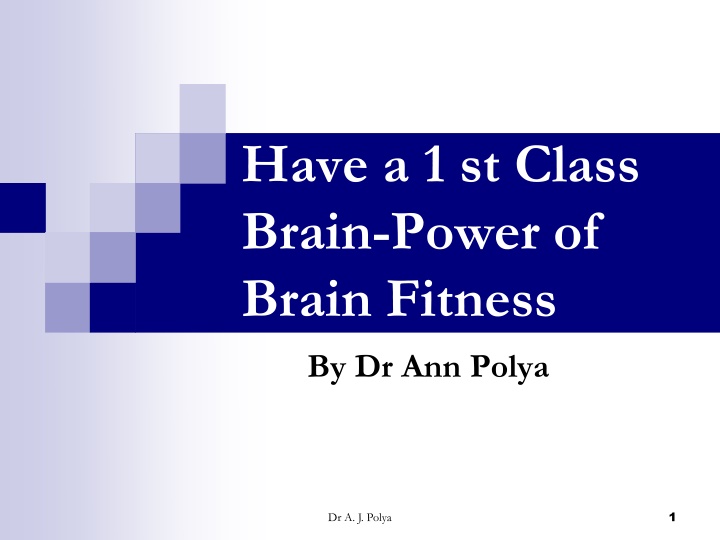

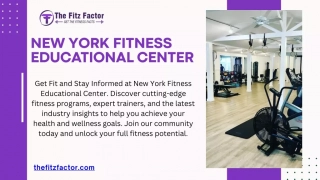

![[PDF⚡READ❤ONLINE] Zen Mind, Beginner's Mind: 50th Anniversary Edition](/thumb/20459/pdf-read-online-zen-mind-beginner-s-mind-50th-anniversary-edition.jpg)
